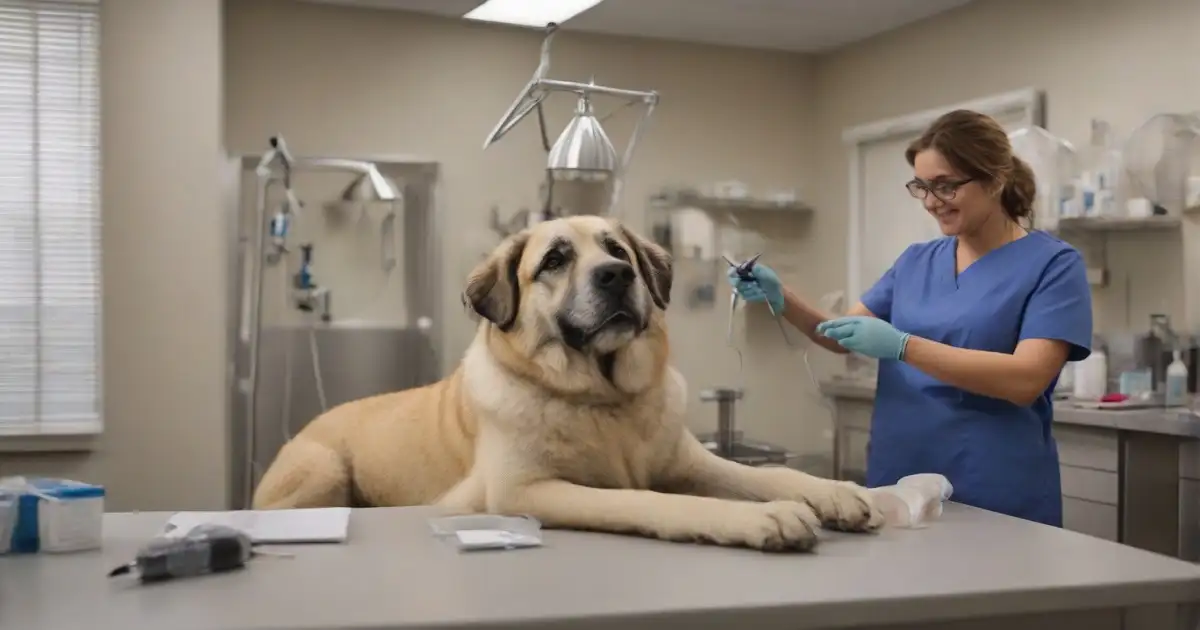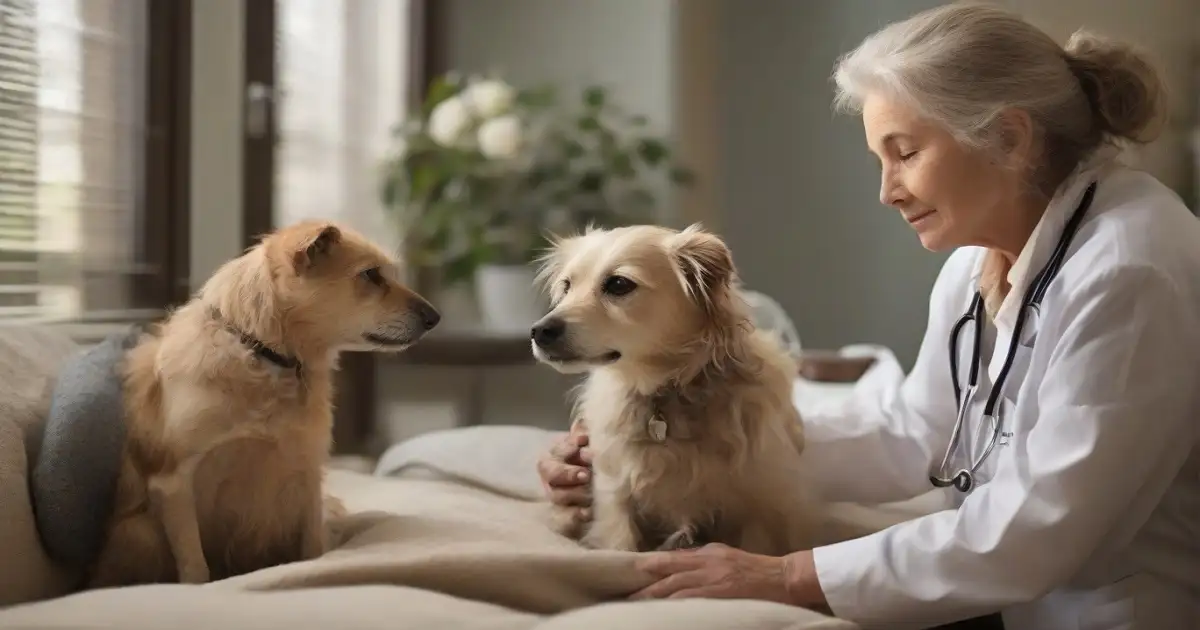Anatolian shepherd dog health issues are a crucial aspect responsible owners must understand. Before bringing home this ancient livestock guardian breed, they must be prepared for their potential health concerns.
Although Anatolian shepherds are known for their incredible strength and stamina in protecting flocks, their lifespan averages only 11 to 13 years.
Being a large breed prone to life-threatening conditions like bloat and cancer, owners must monitor their diet, weight, and signs of illness and have emergency plans in place.
While hip dysplasia, hypothyroidism, and eye, heart, and digestive problems plague Anatolian Shepherd dog health, proper preventative care and vigilant wellness checks can help your resilient working companion live happily for years overseeing their wooly charges.
This article will explore key areas that require attention to keep these noble guardians by your side.
Anatolian Shepherd Dog Health Issues: Common Health Problems
Hip and Elbow Dysplasia
As a significant and rapidly growing breed, Anatolian shepherds are prone to developmental orthopedic diseases like hip and elbow dysplasia.
This painful condition occurs when the ball and socket joint fails to form correctly, leading to joint laxity, arthritis, and mobility issues.
Awareness of dysplasia causes, symptoms, and treatment options will help owners support their companion’s well-being.
What Causes Dysplasia
While genetic predisposition plays a central role, environmental factors also come into play. Overfeeding puppies during growth spurts places extra pressure on developing joints, and trauma and overexertion early on further strain tissues. These influences cause instability and degenerative changes over an Anatolian’s lifetime.
Recognizing Symptoms
Often emerging between 6-12 months old, the first red flags involve stiffness, limping, trouble standing up, and lack of stamina during exercise.
As dysplasia advances, muscles may atrophy, and the range of motion decreases further, limiting activity.
Anatolian shepherds also exhibit pain, vocalizations, aggression, or depression. Without intervention, most dogs will suffer from worsening arthritis and struggle to perform working duties into adulthood.
Getting a Diagnosis
Initial examinations check for soreness, swelling, looseness, and loss of function. X-rays provide a definitive diagnosis by revealing poor femoral head coverage, osteophytes, and other degenerative bone/tissue changes.
Scores help classify dysplasia as mild, moderate, or severe. Further CT scans assess bone integrity, while MRI spots soft tissue damage. Early screening by age 2 prevents pain and irreversible damage.
Treatment Options
Nonsurgical options like rest, medication, physiotherapy, orthotics, and dietary supplements aim to relieve discomfort, slow progression, and retain movement.
Weight management protects against additional strain on affected joints. In moderate-severe cases, corrective surgeries such as FHO/THR, DPO, TPO, and DARthro may be advised to realign and stabilize hip function long-term.
Most dogs can return to active guarding duties after recovery. Committing to nonsurgical or surgical routes requires owners to accept the intensive process and financial obligations in managing this prevalent anatolian shepherd dog health issue.
Bloat
As a large, deep-chested breed, Anatolian shepherds are prone to bloat – life-threatening if not treated urgently. When the stomach becomes overstretched with gas and fluid, it can twist on itself or block veins, leading to toxin buildup, shock, and tissue death.
Awareness of preventative steps and early recognition of symptoms is key to protecting your companion’s safety.
What Triggers Bloat
While the exact causes are unknown, experts believe multiple factors create the right environment for bloat. Eating one large meal per day, having closely related family members with bloat history, stress, intestinal disease, and genetics may all play a role.
Gulping food or water, especially with dry kibble that expands, further distends the stomach. Vigorous activity after eating may also contribute by promoting fluid and gas accumulation.
Spotting Bloat Symptoms
Owners should monitor for first signs like restlessness, drooling, retching without vomit production, and hunched posture, indicating abdominal pain and distress. As bloat advances, the stomach expands, causing pale gums, weak rapid pulse, collapse, and eventual shock.
Dogs may also exhibit “phantom running” due to confusion from reduced blood flow to the brain. Timely emergency intervention gives the best chance for recovery.
Reducing Future Bloat Risks
Veterinarians advise dividing daily food into multiple smaller portions instead of one large meal to decrease volume. Unique bowls also slow speed eating. Restricting activity for at least an hour after meals also promotes better digestion.
While some prophylactic pexy surgery options exist to prevent twisting, these only treat a consequence rather than the root issue. Awareness of individual triggers and monitoring eating habits remain necessary for bloat prevention.
Ensure all family members can spot telltale indicators, have emergency numbers handy, and respond quickly if symptoms arise.
Catching bloat early dramatically improves survival odds for afflicted Anatolian shepherd companions. Remaining constantly vigilant after meals and during stressful events gives peace of mind.
Demodectic Mange
Anatolian shepherds frequently suffer from demodectic mange – a parasitic skin condition triggered by immune system dysfunction.
Whereas most dogs host low non-problematic mite levels, certain influences cause overpopulation and inflammatory reactions. Learning to spot and properly treat symptoms provides relief while restoring coat health.
What Causes Mange Flareups
Demodex mites live in hair follicles and usually only proliferate when immunity falters, allowing the infection to run rampant.
Factors like poor nutrition, stress, hormonal changes, neglect, and unsanitary conditions enable these microscopic parasites to take over.
Since anatolian immunity genes remain isolated for centuries, overvaccination may also overly stress defenses.
Generally beginning around 3-6 months old, demodectic mange tends to resolve once maturity strengthens the immune response unless an underlying condition persists.
Recognizing Mange Signs
Circular bald patches with scaly skin first emerge on the face, front legs, and underside. As hair loss spreads across the body, a moth-eaten appearance results in pustules and secondary skin infections.
Symptoms frequently begin subtly and then rapidly worsen. Severe irritation leads to obsessive scratching and self-mutilation. Transmission risks stay low since mites live no more than 48 hours off a host.
Treating Mange Cases Effectively
Veterinary skin scrapes and biopsies confirm suspects by detecting increased mite counts. Secondary bacterial infections also require antibiotic treatment. Oral ivermectin eliminates parasites for mild cases over 8-10 weeks, along with medicated dips and shampoos to soothe skin.
More extensive mange requires aggressively boosting immune tolerance long-term through combination drugs.
Anatolian Shepherd Dog Health Issues: Unveiling Additional Concerns
Anatolian shepherd dogs have a vigilant eye that goes beyond the ordinary. To safeguard the well-being of these furry companions, owners must tune into a diverse spectrum of health considerations.
Allergies
Anatolian shepherd dogs, much like their canine counterparts, may dance to the tune of allergies. Understanding the melody of common allergens becomes the orchestra for managing their impact.
Be it the sway of environmental triggers or the rhythm of specific food sensitivities, vigilant management is the conductor orchestrating a symphony to mitigate allergic reactions and ensure your canine companion dances in comfort.
Eye Problems
The captivating gaze of an Anatolian shepherd dog, a window to their soul, can sometimes be shrouded by specific eye issues.
Owners become the vigilant guardians of these ocular treasures. Entropion, a ballet of the eyelid rolling inward, leads to discomfort, an unchoreographed misstep. Amidst this dance, watch for cataracts and the cameo appearance of the cherry eye, a third eyelid protrusion.
Regular check-ups with a vet become the choreography, ensuring early detection and a harmonious intervention.
Heart Disease
In the symphony of health, Anatolian shepherds, akin to large breed virtuosos, may face heightened heart disease risks.
Owners become keen listeners attuned to the subtle notes of lethargy, the rhythmic coughing, or the breathless difficulty of a dog’s breath.
Like instrumental heartworm prevention, regular screenings become the conductor’s baton for early detection and a compelling management melody.
Cancer
Anatolian shepherd dogs, regal in stature, aren’t immune to the looming specter of cancer. Vigilance becomes the sacred guardian, identifying potential issues in the embryonic stages.
Watch for the solo performances of mast cell tumors, the haunting hemangiosarcoma, the melancholy of lymphosarcoma, and the bone-chilling osteosarcoma.
Regular vet visits, an ode to awareness, contribute to timely interventions and a comprehensive serenade against the discord of cancer.
Reproductive Issues
Understanding reproductive health takes center stage for those pondering the dance of breeding Anatolian shepherds. Watch for the sultry notes of pyometra, a potential uterine infection casting shadows on unspayed females.
The complications from breeding become improvisational jazz, demanding owners to navigate potential challenges with the finesse of a seasoned conductor.
Responsible breeding practices, the virtuoso’s craft, and regular veterinary consultations compose the masterpiece ensuring the reproductive well-being of these majestic dogs.
Nurturing Vitality: The Significance of Health Screenings
In the tapestry of caring for Anatolian shepherd dogs, the melody of health screenings plays a pivotal role.
These examinations, akin to a well-conducted symphony, ensure the harmonious well-being of our canine companions.
Tests by Age Puppy Wellness Checkups
In the early movements of their lives, Anatolian shepherd puppies pirouette through crucial developmental phases. Puppy wellness checkups become the overture, setting the stage for a healthy journey.
Veterinarians, akin to seasoned conductors, examine the young maestros, addressing vaccinations, nutrition, and potential health concerns with the meticulousness of a musical score.
Adult Annual Exams
As our canine companions mature into majestic adults, the care rhythm evolves. Adult annual exams, the recurring verses of their health narrative, bring the nuances of experience.
These examinations delve into the crescendo of preventative care, encompassing vaccinations, dental health, and tailored screenings for breed-specific health considerations.
Recommended Screenings
In the grand composition of Anatolian shepherd dog care, certain screenings emerge as the virtuosos, playing pivotal roles in the orchestration of well-being:
- Hip and Elbow Evaluations:
-
- Akin to a thorough instrumental assessment, these evaluations scrutinize joint health, ensuring the fluid movement essential to the Anatolian Shepherd’s agile stature.
- Eye Exams:
-
- The canine gaze, a symphony of emotions, is safeguarded through routine eye exams. These examinations detect issues early, preserving the visual harmony of our beloved companions.
- Thyroid Panels:
-
- The thyroid, an often overlooked maestro of bodily functions, undergoes scrutiny in these panels. Monitoring thyroid health contributes to the overall harmony of the Anatolian Shepherd’s well-being.
- Cardiac Exams:
-
- The heart, the rhythmic conductor of life, undergoes its examination. Cardiac exams, like a vigilant conductor’s baton, detect potential irregularities early, ensuring the enduring melody of a healthy heart.
In embracing these screenings, owners become devoted orchestrators, conducting a symphony of care that echoes through the lives of their Anatolian shepherd dogs.
Nurturing Well-being: Guiding Your Majestic Companion to Health
Caring for your Anatolian shepherd is an artful symphony that intertwines love, attention, and proactive measures, ensuring the vitality of your majestic companion. Let’s explore some indispensable tips to enrich the well-being of your loyal friend:
Diet and Nutrition
Fueling the robust Anatolian shepherd demands a diet tailored to their significant breed needs. Delve into high-quality dog food, an orchestra of proteins, essential fats, and nutrients.
Gauge portion sizes routinely to maintain a healthy weight, and consult your vet, your trusted nutrition conductor, to customize a plan that caters to your dog’s needs.
Exercise Requirements
Unleash the boundless energy of your Anatolian shepherd through a rhythm of regular exercise.
Engage in activities that choreograph body and mind – daily walks, playful sessions, and mentally stimulating games.
This isn’t just a dance for physical health; it’s a performance curbing potential behavioral issues, creating a seamless bond between you and your furry companion.
Grooming and Coat Care
The luscious coat of your Anatolian shepherd deserves a spotlight, demanding regular attention. Brush through its strands, orchestrating the removal of loose fur and preventing matting, especially during shedding seasons.
Routine grooming isn’t just a cosmetic routine; it’s a vigilant watch, allowing you to monitor for any skin abnormalities or signs of discomfort, a melody of care.
Vaccinations and Parasite Prevention
Stay ahead in safeguarding your Anatolian shepherd’s health with a robust vaccination schedule. Consult your veterinarian, the wise health conductor, to ensure your dog receives the essential vaccines and fortify their defenses against common canine diseases.
Enhance your protective suite with a comprehensive parasite prevention plan – a shield against fleas, ticks, and heartworms, the unseen adversaries.
Embracing these tips transforms you into the guardian of your Anatolian shepherd’s well-being, sculpting a life filled with health, happiness, and shared moments of joy.
After all, in this grand symphony of care, you are the virtuoso and your loyal companion, the cherished melody.
Signs of Illness Requiring the Vet
Vigilance over your Anatolian shepherd’s well-being involves tuning into subtle signals that speak volumes about their health. Here are key indicators that warrant a vet visit, ensuring proactive care for your loyal companion’s vitality:
Monitoring Behavior Changes
In the intricate dance of canine behavior, deviations from the norm often signal underlying concerns. Keep a keen eye on your Anatolian Shepherd’s habits – a sudden shift in energy levels, alterations in eating or drinking patterns, or unexpected mood changes.
Such anatolian shepherd dog health issues may act as whispers, urging you to seek professional guidance promptly.
Tracking Weight Loss/Gain
Weight fluctuations can serve as a compass pointing toward potential health issues. Regularly monitor your dog’s weight, recognizing any unexplained loss or gain.
While some variations are expected, persistent changes may indicate underlying problems necessitating vet expertise.
Don’t let weight become a silent messenger; instead, use it as a cue to address potential anatolian shepherd dog health issues head-on.
Recognizing Pain or Discomfort
Dogs, masters of masking pain, may subtly communicate their discomfort. Be attuned to signs such as limping, changes in posture, or vocalizations indicating pain.
Any indication of physical distress should be a call to action, prompting a visit to the vet.
Addressing pain promptly ensures your dog’s comfort and tackles potential anatolian shepherd dog health issues before they escalate.
In the symphony of canine health, staying alert to these signs transforms you into a vigilant guardian, proactively steering your Anatolian shepherd away from potential health pitfalls.
Remember, timely veterinary attention is the key to sustaining the vibrant melody of your loyal companion’s well-being.
Nurturing Your Anatolian Shepherd for the Long Haul
Caring for your Anatolian shepherd is a continuous commitment that spans their entire journey. Long-term care requires meticulous planning, team collaboration, and readiness for the unexpected twists that life may throw your way.
Let’s embark on this guide, navigating through both the peaks and valleys of your loyal companion’s life:
Building a Dedicated Care Team
Embark on the path of long-term care by curating a dedicated team, much like the conductors shaping a symphony. This ensemble should feature your dependable veterinarian, a skilled groomer, and a compassionate trainer.
Regular check-ins with your vet, conversations about dietary requirements, and collective efforts to tackle potential anatolian shepherd dog health issues weave together a holistic approach to your dog’s well-being.
Preparing for Emergencies
Life’s symphony often surprises us with unexpected notes. Establish a robust emergency plan to navigate unforeseen challenges gracefully.
Identify the closest 24-hour veterinary clinics, keep a pet first aid kit within reach, and familiarize yourself with basic emergency procedures.
By anticipating potential anatolian shepherd dog health issues and gearing up for emergencies, you become the steady guide steering your dog through life’s unpredictable compositions.
In the grand orchestration of caring for your Anatolian shepherd in the long run, you step into the role of a conductor, intertwining threads of health, collaboration, and readiness.
Addressing potential anatolian shepherd dog health issues with foresight and care ensures your loyal companion’s life becomes a melodious journey, resonating with love and well-being.
Establish a robust emergency plan to navigate unforeseen circumstances. This involves identifying the nearest 24-hour veterinary clinics, having a pet first aid kit, and understanding basic emergency procedures.
By anticipating potential anatolian shepherd dog health issues and preparing for emergencies, you become the unwavering conductor guiding your dog through life’s unpredictable orchestrations.
Planning for End-of-Life Care Decisions
As your loyal companion ages, confronting the inevitable becomes part of the journey. Plan for end-of-life care decisions with sensitivity and compassion.
Discuss potential palliative care options with your vet and establish your preferences regarding euthanasia or other compassionate measures.
This thoughtful approach, though challenging, ensures your Anatolian shepherd’s final movements are orchestrated with the love and dignity they deserve.
In the grand composition of caring for your Anatolian shepherd long-term, you become the maestro, weaving together the threads of health, compassion, and preparedness.
Addressing potential anatolian shepherd dog health issues with foresight and care ensures that your loyal companion’s life is a harmonious melody, resonating with love and well-being.
Conclusion
In the symphony of a lifelong commitment to your Anatolian shepherd, fostering well-being becomes both an art and a responsibility.
Through careful planning and collaboration with a dedicated care team, you assume the role of the conductor, orchestrating the harmonious notes of your dog’s health.
From routine check-ins to emergency preparedness, every element is vital in ensuring your loyal companion’s melody is vitality and joy.
As we navigate the highs and lows of this journey, addressing potential anatolian shepherd dog health issues with foresight and care is paramount.
By embracing long-term care responsibilities, you sculpt not just a pet-owner relationship but a partnership in creating a life symphony filled with health, happiness, and shared moments of harmony.










2 thoughts on “Anatolian Shepherd Dog Health Issues: Discover How To Keep Your Loyal Companion Thriving”